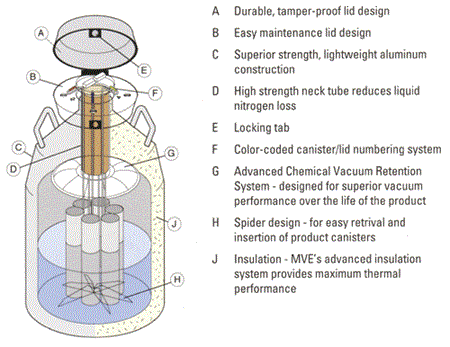Liquid Nitrogen Freezers
What are Liquid Nitrogen Freezers?
Liquid Nitrogen freezers use liquid nitrogen to freeze biological material in extremely cold temperatures (between -136 to -196degC). When living cells are stored at such low temperatures, they go to sleep rather than die. Decades or even centuries later, the frozen cells can be safely thawed with no loss of life or degradation of DNA due to their long storage.
Other Names: Cryogenic Freezers, Cryogenic storage Freezers, Liquid Nitrogen Dewars, Biobank
Why Store Biological Samples At Low Temperatures?
Cryopreservation for biobanking purposes is a method of preserving biological samples (tissue or cells) in a vitrified state (a rapid version of freezing that prevents the formation of ice crystals by taking a sample to the amorphous ice phase, circumnavigating the hexagonal ice phase) for the purposes of long term storage. Because the temperatures used for cryopreservation are so low, all the water inside the cells of a sample is either vitrified or removed by osmosis. As a result, when a sample is cryopreserved, all of its metabolic processes have ceased. Essentially, it is “frozen in time.” The advantages of cryopreservation for sample storage include:
- Since most identified metabolic processes stop at temperatures below the glass transition phase (the transformation from liquid to a glassy state), cryopreservation reduces the risk of microbial contamination or cross contamination with other tissue or cell samples.
- Likewise, in the vitrified sample itself, the risk of morphological and/or genetic changes is significantly reduced since metabolic processes have stopped. Preserving below the glass transition phase enables access to samples for future needs.
- Cryopreservation techniques are well-established, and there’s a long history of reliable methods and documented outcomes.
The list goes on, but it’s clear to anyone in the biobanking industry that cryopreservation is an extremely effective method for the storage of biological samples. But don’t misunderstand: It is not trouble-free. The process of sample preparation requires a researcher to determine conditions that will optimize sample viability and recovery, ensuring the samples are guided safely through the vitrification and de-vitrification processes to avoid (as much as possible) the formation of ice structures. Samples undergo tremendous stress during the freezing and vitrification processes. Over the years, research scientists have developed many techniques to help abate the impact of these processes, including the development of cryoprotectants (which first occurred in 1949, see Polge et al. Nature 164: 666 ) and the birth of controlled rate freezers to assist in the path to vitrification. Today, there are more sample preparation protocols then sample types being stored, each with its own pros and cons.
How Does it Work?
Liquid nitrogen is filled into a dewar capable of insulating the tempearture and minizing the effect of ambient temperature. The LN2 is filled to about 1/3 of the volme of the tank. Samples are placed in canisters or cryoracks. The tempreture of LN2 is around -196degC and the evaporation of LN2 in the sealed tank creates a freezer with temperatures between -196degC and -136degC. For safety reasons samples are not stored directly in the liquid nitrogen but within the liquid nitrogen vapour.

Sample Racks
Samples are placed in a LN2 freezer by either a Cannister or Rack.
![]()
Cannisters: Cylindrical in shape. Holds either sample canes or straws.

Canes: Use hold cryovials. Vials are placed in cannisters which are then placed in the LN2 Freezer.
Straws: A cryopreservation straw is a small storage device used for the cryogenic storage of liquid samples, often in a biobank or other collection of samples. Their most common application is for storage of sperm for in-vitro fertilization. Straws are placed in cannisters which are then placed in the LN2 Freezer.

Racks: Used to hold Cryoboxes. Placed directly into the LN2 freezer
Information Required to quote on a LN2 Freezer
- How will you store your samples? Canes? Straws or Vials/Boxes?
- How many samples do you want to store?
- Do you need temperature display?
- Do you need low LN2 display?
- Do you need an automatic filling system for liquid nitrogen?
- Do you need accessories? Canes and Canisters or Racks?
Videos
https://youtu.be/GolhwDQqH7w
